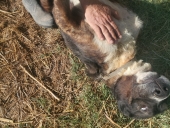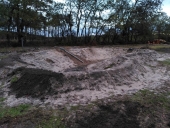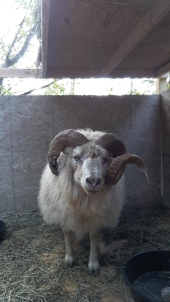Hi there!
I have muscovy ducks, and can answer some of these questions!
Are you planning on doing anything else to the sandy 'pond' to seal it and capture rainwater, or what's your plan there? Muscovies poop a lot, but I reckon it would take a long time to line an entire pond, especially with 3-4 ducks!
A shelter is good, they don't need much. I've found them to be pretty sturdy ducks. I think my climate is colder/wetter than yours and they do all right here in a little shed with just straw on the floor. They don't like the snow, but I don't think many ducks do!
I feed mine a brand of bird feed called 'all flock' - just a broad-spectrum bird feed that they really love. I guess it depends how much kitchen scraps you produce, but I'd keep a bag of commercial food (or however you can get grain) on hand to feed them if your family doesn't produce enough for them. It could be hard to tell on adults, but I have a sense of how fast they should grow now after a couple years of having them, so I can tell when to increase their food as they go from chicks to adults. Keep an eye on how much they seem to successfully forage in your area as well. Your pond looks pretty dry right now, but normally they'll forage through grass and clover and bugs. Mine dig around in the muck at the bottom of the pond, I have no idea what they find to eat down there! As for kitchen scraps, I've seen my ducks eat just about everything even remotely resembling food. They will probably surprise you lol. Chicken bones, peach pits, every kind of fruit and vegetable skin, they eat EVERYTHING. I don't compost anything, the ducks get it all and put it in the pond haha!
My neighbor has a nice electric fence that is a flexible net-type thing, on movable posts, so he can move the fence around for his sheep. That would probably be great for them, especially as you get a feel for what they like to do on your property. You might be moving them around a lot as you get them settled, so a mobile fence would be convenient. I don't know what it's called, but you're in France, too, so you and Google will have to have a chat to see what's available!
There are also two sort of kinds of muscovies, there's a breed that's been very domesticated, and usually comes in white/brown coloration, and more wild ones that are typically variations of black. The white/brown ones are slow and heavy and don't fly well. The black ones however are pretty spry, and without a net covering over their area they'll likely be able to escape pretty easily, especially if there's more forage outside the fenced area! I let mine free-range, and with a pond available to them to jump onto, the predators have only caught a few. They reproduce really well so I've been able to keep the flock going. I'm currently mixing white/brown genetics with the black ones to see if I can get fat and spry ducks! Anyway, if you're feeding them, they likely won't have a good reason to escape, so the fence is mostly to keep predators away, if you think that will be a problem in your area. My ducks are really friendly, and follow me into the shed every night to get locked up so they don't get eaten while they're asleep.
You should definitely keep water out for them! Ducks have pretty delicate sinuses that need to be kept wet all the time. They also like to wash down all their food with water, and splash and bathe themselves constantly. People without a pond usually keep a 'kiddie pool' full of water for the ducks - it's like a big plastic pan, maybe 2 meters across and 30cm deep. They'll turn it to mud in a day or so, so you'll have to refill it every day probably. Ducks are really dirty!
I got lucky and my property had a little boat shed on edge of the pond that I use to keep them in at night. I feed them to get them in it at night, so I give them a big bowl of water to drink, and it's always gone by morning, but I've never had problems limiting their water like that overnight, so they don't HAVE to have access to a lot of it at night. Any chicken coop style shelter should work, I'm sure there's lots of designs on here! I keep the bottom covered in straw, since they're constantly wet. I try and dig it out every couple weeks, which is a great source of mulch/fertilizer. They produce a lot of poop, and I think it's pretty high in nitrogen, but I'm still getting things in order to be able to use it, so it's in a big pile outside their house.

Oh breeding - if you're new to ducks or birds in general, they can be kind of nasty to each other, so I'll just prepare you now. Try to keep your ratio of male to female around 1 male to 3-5 females. The males will fight if there's not enough girls to go around. And - to be blunt - ducks are pretty rapey. The males will mount the females pretty aggressively, and when they have water they'll do it there, and really dunk the females - like you'll be worried they're drowning. They're probably fine (I haven't had any deaths because of that) but I do yell at them or poke the males off with a stick if it's clear they're done and still on top of her. That being said, the eggs are delicious, and they are pretty good mothers! I've had girls go broody on anywhere from 4-19 eggs, and hatch almost all of them. They may need some help keeping everyone together, but I've *mostly* had really good mothers!
Ok that's all I can think of, good luck!












